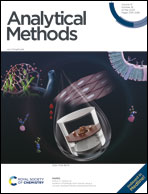Carbonized loofah sponge-based solid-phase extraction of benzo[a]pyrene from fish followed by liquid chromatography-ultraviolet detection†
Abstract
A simple and sensitive method combining solid-phase extraction (SPE) and high-performance liquid chromatography-ultraviolet detection (HPLC-UV) was developed for the determination of benzo[a]pyrene (BaP) in fish. Loofah sponge (LS) was carbonized and used as an SPE adsorbent. Carbonization decreased the polarity of LS and enhanced its aromaticity. Carbonized loofah sponge (CLS) could capture BaP better through π–π interaction. The carbonization temperature and the SPE conditions were optimized. The linear range of the developed method was within 10–1000 ng g−1 with a satisfactory correlation coefficient (R2) of 0.9999. The limit of detection (LOD) was 2.0 ng g−1, which was below the maximum residue limit (5 μg kg−1) in meat set by the European Union. The method showed good intra-day and inter-day precision with relative standard deviations (RSDs) ranging from 0.4% to 1.7%. Finally, the developed method was applied to the determination of BaP in fish samples. This method is low-cost and environmentally friendly with natural and renewable LS as raw material and it provides an alternative approach for the efficient and simple determination of BaP in aquatic products.
![Graphical abstract: Carbonized loofah sponge-based solid-phase extraction of benzo[a]pyrene from fish followed by liquid chromatography-ultraviolet detection](/en/Image/Get?imageInfo.ImageType=GA&imageInfo.ImageIdentifier.ManuscriptID=D3AY00442B&imageInfo.ImageIdentifier.Year=2023)


 Please wait while we load your content...
Please wait while we load your content...